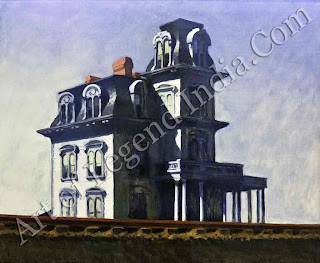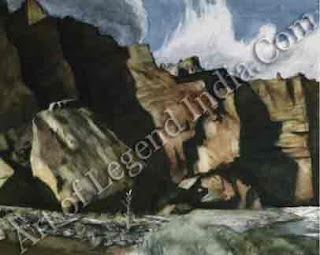American Great Artist Edward Hopper - Silence And Solitariness
Posted by
Art Of Legend India [dot] Com
On
1:40 AM
Edward
Hopper at work
Hopper's highly original work gives us an uneasy view of
modern life in America, stressing in particular the loneliness and isolation of
man in the urban environment.
By temperament and by training, Hopper was a realist.
Following in the aesthetic tradition developed by Manet, Degas and the
Impressionists in the nineteenth century, he had no time for idealization,
prettification or fantasy he had no time for beauty, in the conventional sense
of that word. His aim was to recreate the experience of reality intensely
perceived, showing us the kind of people, places and things that we might see
every day, yet somehow imbuing them with that strange and elusive quality we usually,
for want of a preciser term, call 'mood'.
At his best, Hopper was a painter of modernity he delighted
in representing those things that make modern life modern, from petrol stations
to cafeterias. His main province is the public place; private life is only
glimpsed through window, in doorways, at a distance. He presents a detached
view, as if observing modern man for the purposes of some behaviour study. His
brushwork is slow, deliberate and dull, like the most deadpan of commentaries,
and his colour can be almost cruelly harsh, seeming to condemn the garishness
of modern taste.
Hopper disliked being pigeon-holed as a painter of 'the
American scene' there seemed something patronizing about it. Yet the modern
life he depicts is unmistakably and insistently modern life in the USA.
Hopper's great strength was his eye for a good subject, and what better subject
for a painter of modernity than a New World, the discordant grandeur of which
had virtually never been exploited in art?
Though Hopper is best known as an oil painter, some of his
most important early work was in watercolour and etching. He first won
recognition as a painter with the daintily executed, sunlight-filled
watercolours he made in Gloucester, Massachusetts in 1923, and he continued to use
the medium with a relaxed, lively touch throughout his life. The
black-and-white technique of etching lent itself more readily than watercolour
to representing the seamy side of the American scene, and Hopper's etchings of
the early 1920s dwell upon landscapes cut across by railway tracks and life in
cheap apartment blocks. It was here that we see his peculiar brand of realism
beginning to emerge.
One of the leading ideas in Hopper's work is the inhumanity
of the manmade. He can suggest the hugeness and bleakness of a big city by
showing just a street corner or the view from a train window. Architectural
forms take on a strange alien presence, mean, hard and repetitive in the city,
aggressively ornate in the suburbs and small towns. Sometimes the environment
is allowed to speak for itself, like a stage-set without actors. Elsewhere
there are people, but they are somehow temporary; they seem not really to
inhabit the place where they happen to be.
The principal legacy of Hopper's Paris days, when he saw and
imitated the work of the Impressionists, was an abiding interest in the play of
light and shade on objects, especially the effects of sunlight on buildings,
inside and out. Hopper orchestrates light as ingeniously as any lighting
manager in the theatre, and the shadows and areas of light take on as much of a
life of their own as the figures and objects over which they play. Indeed, they
perform the crucial function of enlivening and competing with those figures and
objects.
The angles from which Hopper's subjects are viewed may look
casually chosen, even accidental. He will sometimes crop a scene so that a
figure is cut in half; sometimes show the main figure to one side as if by
mistake, allowing most of the composition to be taken up with something
ostensibly rather boring. But these are calculated and essential effects, often
to emphasise a sense of alienation. Photographs might also play a part in the
process, although the image is always quite transformed in the final painting.
Another of Hopper's recurrent themes is transience. His
scenes of travel carry implications that transcend the modern-life context they
stand in an age-old poetic tradition in which the journey is used to suggest
man's journey through life. The roads and railways in Hopper's paintings, the
travellers sitting on trains or waiting for who knows what in hotel rooms and
lobbies, are images of human existence as a transient thing, images of
mortality.
The people in his work often seem-to be in a world of their
own, gazing dreamily into space or intently reading. Sometimes the parts of the
setting around their heads or in front of their eyes will seem to contain their
hovering thoughts, but there is rarely any sense of communication between them.
Instead, they tend to be divided from one another by the furniture or the
architecture into separate compartments of space. They are not brought together
by any definite storyline either. Despite his training as an illustrator,
Hopper deliberately avoids narrative content in his works. Something is going
on but there is no way of telling what, and the situation is all the more
fascinating for its ambiguity.
Hopper was above all a master of expressive space and, in a
way, the spaces between the figures are more important than the figures
themselves. The world he creates in his paintings seems to yawn with emptiness.
Most obviously, he will use empty seats to suggest absence, imparting a lonely
and isolated air to the people who are present. More subtly, his compositions
are contrived to make us look for something that is not there, to give an
uneasy feeling of watching and waiting for someone to arrive, or some event to
occur. To increase our unease, he will slightly distort perspective, just
enough for us to sense that something is wrong without being able to say
exactly what it is. He was a realist, but with an angle, and his aims and
methods were hardly as straightforward as that term might imply.
Writer
– Marshall Cavendish
Subscribe to:
Post Comments (Atom)
















0 Response to "American Great Artist Edward Hopper - Silence And Solitariness"
Post a Comment